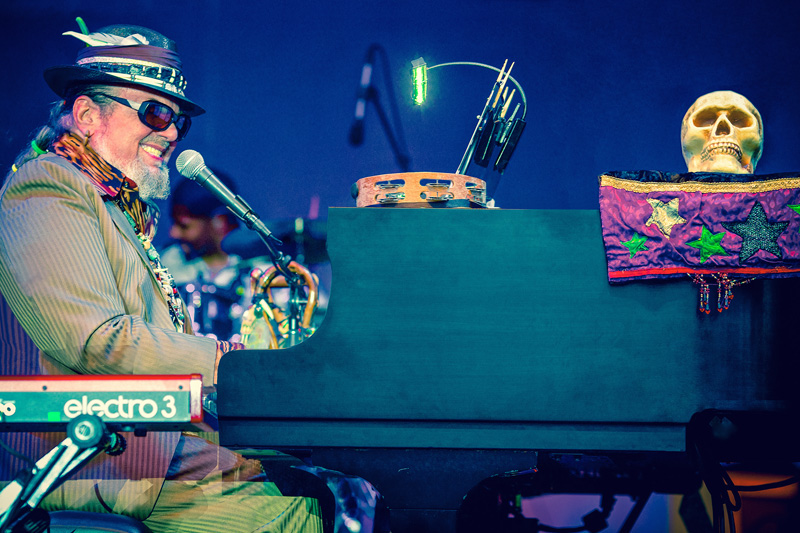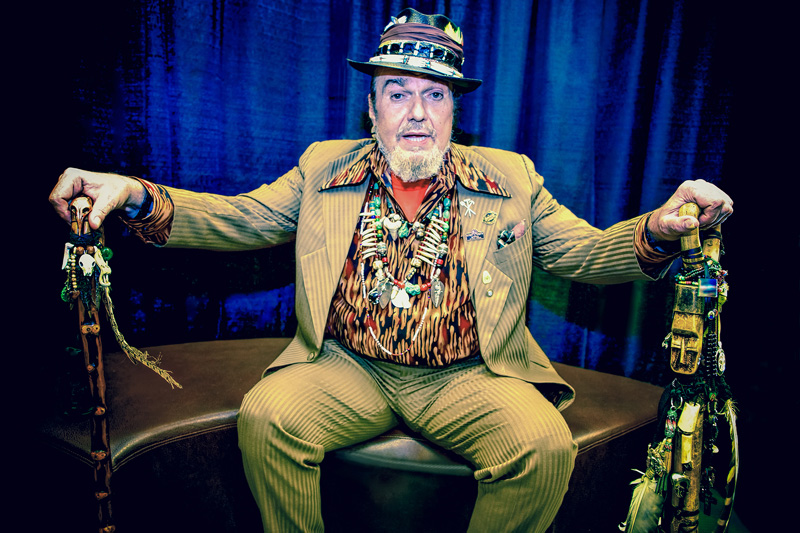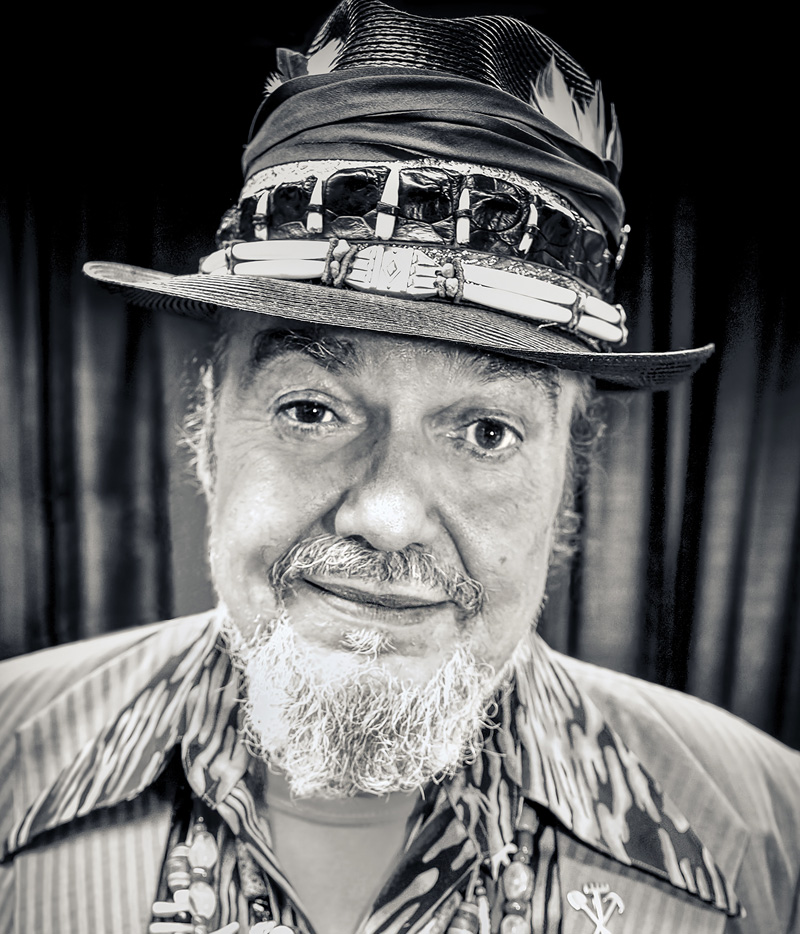Final Bow For The Night Tripper – A Tribute to Dr John
Monday, June 10, 2019
Refuting the title of his biggest hit, ‘Right Place, Wrong Time’, Macolm John Rebennack Jnr, aka Dr John, who died of a heart attack on 6 June, grew up at the centre of a seething music scene in New Orleans in the 1950s.

His resourceful record store proprietor father used to fix PAs around town for such acts at Papa Celestin, Dave Bartholomew, the Basin Street Six and Professor Longhair and his young son insisted on tagging along, eager to befriend the musos, despite dad’s insistence to stay in the car. Rebennack came from a musical family with assorted aunts who would jam around the white baby grand that beguiled him in the front room of his grandparents’ house. Intimidated by established local pianists he admired like Salvador Ducette, Tuts Washington, Herbert Santina and Roy Byrd (‘Longhair’), however, Rebennack started on guitar, formative teachers being Fats Domino sideman Walter ‘Papoose’ Nelson and jazzman Roy Montrell. Partly ‘Right Place, Wrong Time’ probably accounts for the sixth grader’s habit of skipping 8am mass at Catholic school to catch the last set of the all night jams at the Brass Rail and other venues on Canal Street.
Regrettably Rebennack was inducted to the world of narcotics as a 12-year-old truant by a shady character and fellow musician known as Shank, who would send the boy on errands to score for him. Ultimately it was the unwittingly suggestive way he played guitar, according to testimony in his memoir Under a Hoodoo Moon (1994) that got Rebennack expelled from Jesuit High School. He’d already started writing songs and selling them to Specialty Records who’d deploy them with Little Richard and Art Neville, worked the “Holy Father circuit” with school band The Spades and hooked up with saxophonist Leonard James and eccentric piano prodigy James Booker, who would later teach Rebennack how to play organ, during lean times in the early 60s. Through his guitar mentors Mac wangled sideman work at Cosimo Matassa’s revered R’n’B studio, concurrently absorbing showbiz craft from drag-queen revues at the Dew Drop, a chitlin circuit mainstay. He also began, in 1956 or 57, producing for Johnny Vincent’s Ace Records. Meantime backing musician activity with such as Jerry Lee Lewis, Frankie Avalon and Bobby Darin, gave Rebennack seminal experience contracting diverse sidemen. Soon he would challenge the colour barrier insisted on by two local musicians’ unions (on black, one white) backing Bo Diddley (though that gig was pulled mid set) and Jimmy Reed.
Rebennack’s first release Boppin’ and Strollin’ (Decca 1957) was under Leonard James’ name but steadily the groundwork for his future metamorphosis as a leader was being laid - like his hero Allen Toussaint, Mac was first songwriter and house musician. One of his songs, renamed 'Lady Luck' was appropriated by Lloyd Price and became a hit in 1960, which infuriated Rebennack to the point of wanting to shoot Price (he would later be swindled by a duplicitous lawyer who, while ostensibly pursuing royalties for Rebennack, was tacitly in Price’s pocket). That same frustrating year an ugly shooting incident did occur, in Jacksonville, Florida, (not Jackson, Mississippi as stated in other obits). Mac intervened in a fight between a pistol packing motel manager and singer Ronnie Barron (Barron had had an ill-advised assignation with the motelier’s wife). As Rebennack wrestled for the gun a shot damaged his left fretting finger. Disconsolate but needing work, he played stand-up bass in a Dixie group for a while at New Orleans’ Famous Door, then had to switch to bass guitar and ultimately back to the piano. It had actually been Barron, incidentally, several years Rebennack’s junior at Jesuit school, who’s initial persona “the Reverend Ether” inspired him to hatch the voodoo root doctor moniker that would accelerate his fame. He’d originally had “Dr John” in mind as a new stage name for the blue-eyed Barron but Barron baulked at the prospect and ultimately, despite an impressive sideman resume, the younger man’s notoriety was eclipsed – he’s a backing singer on several Dr John releases.

In the early 1960s hypocritical NOLA DA Jim Garrison made a dramatic move to clean up the French Quarter. Overnight a startling number of the clubs on Bourbon Street were shuttered, as well as “Stalebread and Mickie’s whorehouse”, where Rebennack claims he saw Garrison before he turned into “Mr Jive-Ass Morality,” for political reasons, as he saw it. According to Mac, this sweeping sting operation had a devastating effect on the community, which had thrived 24/7 until then. Sharpening law enforcement caught up with Rebennack too: he was busted for heroin possession and ultimately landed at Fort Worth federal facility for “dope fiends”.
Rebennack’s already sleazy lifestyle bottomed out in jail but he picked up a “janitor’s diploma” and his high school certificate with help from a fellow inmate. After he re-emerged in 1965 he was forced to relocate to LA due to parole issues and the work slump in New Orleans and since Harold Battiste – who had founded the first black-owned label in the south (AFO) and was working with Sonny and Cher – offered him studio gigs there. Rebennack held minimal professional respect for Bono or even Frank Zappa, who he briefly worked for, and his time in LA was often squandered producing “lames” as he tagged feeble musicians. He missed the grit, groove and honesty of the New Orleans scene that reared him, and finally, using some left over session time from Sonny and Cher, waxed his debut as Dr John, The Night Tripper. The sobriquet was inspired by an eccentric Senegalese prince called John Montaigne, Bayou John or more commonly Dr John who had an historical connection with New Orleans (Rebennack listed himself as Dr John Creaux).
Gris-Gris (1968) was released on Atlantic subsidiary ATCO, despite Ahmet Ertegun’s protestation “how can we market this boogaloo crap?” Indeed, the psychedelic haze of the debut, apposite to contemporary zeitgeist, initially bombed commercially, yet Gris-Gris was later hailed in Rolling Stone Magazine as an all-time great album, the conga laden adaptation of a voodoo church song ‘I Walk On Guilded Splinters” becoming a favourite with Paul Weller among others. Liner notes to Gris-Gris, worthy of Epicure Mammon from Ben Jonson’s The Alchemist, indicated Rebennack’s commitment to his mysterious alter-ego and a wild hoodoo-drenched stage show ensued. After Babylon (1969), Remedies (1970) and The Sun, Moon and Herbs (1971), the doctor really hit his stride with Dr John’s Gumbo (1972) and In The Right Place (1973), shifting his occult tripster act into that of a riotous celebrant of everything New Orleans, with a Mardi Gras-styled revue.

‘Right Place’ spoke volumes about Rebennack’s heroin-addled misadventures and Emerson Lake and Palmer would title their album Brain Salad Surgery (a slang term for fellatio) after a lyric from this nervy confessional, which peaked at #9 on the Billboard Hot 100. The other hit from the album, Such A Night, may have also held an autobiographical thread, as he once stole his bass player's girl Lydia, who eventually became his first wife.
The garbled make-believe but paradoxical authenticity of Rebennack’s re-invention as a solo act was revelatory to both himself and the public at large and he became as synonymous with the Big Easy as bluesman Buddy Guy is with Chicago. Despite his sojourn to LA, it was his homeboys Allen Toussaint (who produced) and rhythm aces the funky Meters who made killer tracks like the manifesto ‘Qualified’ quintessential. The same team waxed the follow up Desitively Bonnaroo (later inspiring a Tennessee music festival) but sales failed to impress beancounters at Atlantic and Dr John switcheroo-ed to United Artists for one recording, Hollywood Be Thy Name, a skeweringly sarcastic title about his days in la-la land.
A jazzier turn involved Tommy LiPuma who produced the underrated City Lights (Horizon/A&M 1979) drafting in David Sanborn, Will Lee, Plas Johnson and Steve Gadd. The latter two had appeared on Steely Dan’s Aja a year or so earlier and the clean, layered production suggests the influence of Fagen and Becker’s scrupulous studio craft. Though Rebennack had long ago mastered the art of corralling parades of sidemen and arrangers, the softer touches here – pervading Fender Rhodes from Richard Tee and Claus Ogerman string arrangements – were a departure. Languorous big band arrangements tenderised further with In A Sentimental Mood (Warner Bros 1989) but the treacly crooning and cocktail piano won over the Grammy voters and permitted the Dr a mid-life mellow out after his final rehab via Narcotics Anonymous. Perhaps the Mission Impossible string riffs behind his instrumental refashioning of ‘Love For Sale’ were a subtle reminder of his unsuccessful side-hustle as a pimp, shades of that character surface at the track’s fade.
After a musical trip back to New Orleans proper, 1992 yielded another Grammy with a record embracing the Neville Brothers and trad-jazzers Pete Fountain and Al Hirt plying latin grooves, Dr John took a more intimate jazz group on the road and recorded a tribute to Ellington at the turn of the millennium. Duke Elegant (2000, Blue Note) featured guitarist Bobby Broom and baritone saxist Ronnie Cuber and such Ellington obscurities as ‘On The Wrong Side of The Railroad Tracks’, ‘I’m Gonna Go Fishin’’ and ‘Flaming Sword’. As Broom, a member of the band for six years, recalls “His Duke Elegant record was a great representation of the singularity of his interpretive style and also of the supportive chemistry of his working band at the time - the Lower 911. What he was able to do with Ellington’s material is testament to his artistry, he reworked it all making it his own, without overly distorting or disguising it, but approaching from a fresh and unique perspective.”
Despite his scurrilous (yet far from entirely misspent) youth in the city of his birth, Dr John rose to the occasion post Katrina, initially releasing a suite under the heading Sippiana Hurricane (2005), all proceeds from which were divided between the New Orleans Musicians’ Clinic, The Jazz Foundation of America and the Voice of the Wetlands. The EP echoed his first recorded single ‘Storm Warning’ and defiantly urged ‘Wade in the Water/Comin' back like we oughta’ about the disaster, criticising political expediency in the aftermath on a recast ‘Sweet Home New Orleans’. John was similarly excoriating at protest rallies after the Deepwater Horizon oil spill that contaminated the Louisiana shoreline in 2010.
Induction into the Rock and Roll Hall of Fame in 2011 seemed to spell the kiss of career death but then came a remarkable renaissance with Locked Down (Nonesuch 2011). A grungy, reverberant soundscape devised by the brilliant Dan Auerbach, this Grammy winner (one of six) featured the doctor at his dirtiest on analogue keyboards. There seemed a startlingly urgent message here, harking back to part-buried nightmares of incarceration and Rebennack’s deep cynicism about the system, the manufactured braggadocio of ‘Big Shot’ thrown in for truculent measure. Even Rebennack’s apologias ‘My Children, My Angels’ (he has an unrecorded total of offspring) and ‘God’s Sure Good’ were not allowed to sink into bathos by Auerbach, who resolutely maintained the edge he saw at the heart of the exotically seasoned seventy year old.
Dr John’s star studded last studio album Ske-Dat-De-Dat: The Spirit of Satch (Concord 2014) paid tribute to a formative influence from his hometown, who also came through a colourful period in New Orleans history and perpetrated inaccuracy about his birthdate – Louis Armstrong. Rebennack was born on November 20th 1941 not 1940 as most sources quote (pretending to be older behoved him as a teenage hustler and musician).

Ill health was starting to take its toll latterly, including cirrhosis of the liver and bone spurs in the neck Mac attributed to years of methadone treatment, thus for the last eighteen months of his reign Dr John was seldom seen in public, despite high profile appearances prior alongside Bruce Springsteen, Don Was, Dave Grohl and with John Legend and Jon Batiste on the Late Show with Stephen Colbert.
In retracing his recorded legacy, his profound self-marination in the flavours of the bayou and beyond are always impossible to filter, despite wry affectations and Professor Longhair bequeathed patois. The trickstery and dark street tales his intimidating grandmother would tell at bedtime were influential from the get go but there was a beatific simplicity to his outlook also: notwithstanding unsavoury tastes and otherworldly debauchments, the arch underdog’s maverick humour and hard-earned humanity shine through. Formative career lessons as strawboss, producer and A&R man delayed his emergence as a star in his own right, but he made up for lost time when he “hit the bricks again”, on release from prison. Countless sessions with such great producers as Toussaint and Battiste and songwriter colleagues like Jesse Hill and Doc Pomus, belied his own canny, not so uncalculating, brilliance.
Dr John dates were thick with the ‘guilded splendor’ (sic) of astutely curated artistic talent, a gamey mix like the food he enjoyed. He’d worked within Phil Spector’s 'Wall of Sound' but thought Spector’s concept generally demanded toothless musicianship. He revelled in a rich, aromatic, home-cooked sonic gumbo, a clichéd metaphor he wouldn't refute.
“Mac was the epitome and exemplar of an American musician,” summarises Broom, “in that he was comfortable in every major American music style – jazz, blues, R&B, rock and roll and all the offshoots and styles that would follow. He put his 'singularicle' stamp on the music. Thank you and Rest in Peace Dr John.”
– Michael Jackson (Story and Photos)